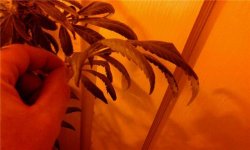xxoshz25xx
Member
Hey all,
I haven't posted here in at least a year or two but I am having a little problem with my New Purple Power. I have a 3x3 room, "my closet", and the temps are ideal in the low 70's. I just watered them 3 days ago with 3 tablespoons of Molasses and yesterday my ladies showed me this problem.
I think it's over watering/over fertilizer but unsure. Can someone chip in here and give me there insight. I am using Cornucopia Plus Formula X which is a great bloom booster. I
Oshz!!!


I haven't posted here in at least a year or two but I am having a little problem with my New Purple Power. I have a 3x3 room, "my closet", and the temps are ideal in the low 70's. I just watered them 3 days ago with 3 tablespoons of Molasses and yesterday my ladies showed me this problem.
I think it's over watering/over fertilizer but unsure. Can someone chip in here and give me there insight. I am using Cornucopia Plus Formula X which is a great bloom booster. I
Oshz!!!




